Royal Rajasthan
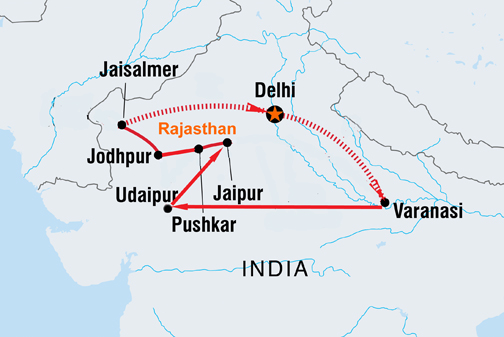
We arrive at 2 am in New Delhi after almost 24 hours of traveling--through Beijing, are met by the Greaves Travel representative, and 20 minutes later have covered the few miles from the airport to the Hotel Trident in Gurgaon—a sort of a high-tech satellite town. With buff-colored stucco, stone colonnades and pale red sandstone domes, verdant courtyards with fountains and broad reflecting pools, the Trident is a blend that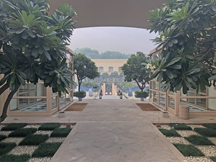 reflects both Mughal and Raj architecture. Room service is 24/7 but on calling down we learn that the tandoor is shut down, and at this hour the kitchen can only provide dal makhani, rajmah masala and grilled paratha and roti breads, along with a cold Kingfisher beer for our 3 am supper....
reflects both Mughal and Raj architecture. Room service is 24/7 but on calling down we learn that the tandoor is shut down, and at this hour the kitchen can only provide dal makhani, rajmah masala and grilled paratha and roti breads, along with a cold Kingfisher beer for our 3 am supper....
The morning sun after a lay-in til 9 is a fuzzy orange egg yolk in the thick pollution that blankets Delhi this morning—made multiple times worse than the normal terrible by the millions of firecrackers set off 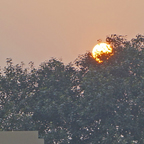 during Divali, the 4000 year old sacred Festival of Lights that began Wednesday, the day we began traveling.....normal Delhi pollution is 25 times the safe level, and Thursday morning was estimated at 3 times that...really very nasty, and eerie…..
during Divali, the 4000 year old sacred Festival of Lights that began Wednesday, the day we began traveling.....normal Delhi pollution is 25 times the safe level, and Thursday morning was estimated at 3 times that...really very nasty, and eerie…..
We spend the travel recovery day with a very late breakfast, a wander around the elegant grounds and gardens, a short gym workout, swim in the enormous pool, and for Troy a massage. After all that activity we head next door to the Oberoi (which hotel group owns the Trident) for a hotel inspection and a bite of samosa and a 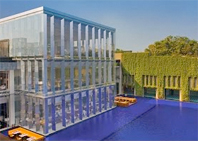 beverage at the lobby bar. The Oberoi’s lobby and public areas are essentially a glass cube overlooking the deep-blue reflecting pool, from which rises an emerald-green living wall, and on which sits a floating deck area. The fine dining restaurant is called Amaranta, featuring creative Indian cuisine, and the Threesixone° grill and bar—the name must refer to round the world cuisine, as Italian—pizzas and pasta, steakhouse, Chinese, Japanese and more are available. After a nap back at the Trident, we return to the glass cube to sip classic martinis in the elegant piano bar, then head downstairs to seats at the sushi bar where Chef Tagaka prepares us impeccably fresh maguro, ama ebi, hotate and shima aji flown in from Tokyo that day....
beverage at the lobby bar. The Oberoi’s lobby and public areas are essentially a glass cube overlooking the deep-blue reflecting pool, from which rises an emerald-green living wall, and on which sits a floating deck area. The fine dining restaurant is called Amaranta, featuring creative Indian cuisine, and the Threesixone° grill and bar—the name must refer to round the world cuisine, as Italian—pizzas and pasta, steakhouse, Chinese, Japanese and more are available. After a nap back at the Trident, we return to the glass cube to sip classic martinis in the elegant piano bar, then head downstairs to seats at the sushi bar where Chef Tagaka prepares us impeccably fresh maguro, ama ebi, hotate and shima aji flown in from Tokyo that day....
Quite jet-lagged, we prepare for an early night with a Negroni in the Trident bar, which is dramatic and faintly Colonial/Art Deco in tone, and then grudgingly call for a 5:30 wake up call for airport transfer and early flight to Varanasi, the holy Hindu city where we will commence this most recent, and probably last visit to vibrant India.
Varanasi
 The holy city of Varanasi, named Benares by the British during the Raj, is our first stop. We first visited almost 25 years ago, and were so captivated that we vowed one day to return...that vow is fulfilled this trip. Full report is here.
The holy city of Varanasi, named Benares by the British during the Raj, is our first stop. We first visited almost 25 years ago, and were so captivated that we vowed one day to return...that vow is fulfilled this trip. Full report is here.
Udaipur

Varanasi to Udaipur is a real pain.....two flights, connecting through Delhi, on separate local airlines, so baggage can’t even be checked through. The schedule requires a 5:30 departure from the hotel, down the ghat, up the river, into the car, through not too terrible early morning traffic...arrive Delhi, claim baggage again, nightmare security again (the Indians separate men and women) onto Spicejet for an hour’s flight. All Indian airports are by decree at least an hour, with traffic, from town. The traffic tangle into Udaipur, mostly holdover Indian tourists from Divali, is monstrous, head-cracking. Finally, we arrive at the edge of lake Pichola and the hotel launch whisks us to the serenity of the Taj Lake Palace Hotel. We are escorted up the steps under a tassled sunshade by one of the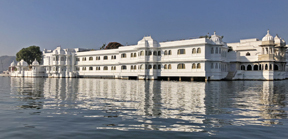 Royal Butlers, a red clad turbaned fellow—this group are said to be descendants of the earlier palace retainers. As we reach the entrance, a shower of carnelian bougainvillea petals gently fall around us....kitschy, but fun. We are shown to a deluxe room on the ground floor overlooking the Udaipur Palace on the near shore. The room is not huge...they maximized the number of rooms on the palace
Royal Butlers, a red clad turbaned fellow—this group are said to be descendants of the earlier palace retainers. As we reach the entrance, a shower of carnelian bougainvillea petals gently fall around us....kitschy, but fun. We are shown to a deluxe room on the ground floor overlooking the Udaipur Palace on the near shore. The room is not huge...they maximized the number of rooms on the palace 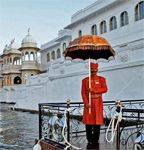 view side, but quite luxuriously appointed. Full report here.
view side, but quite luxuriously appointed. Full report here.
Monday morning we meet our guide Kamal at the hotel boat landing city side. From there we proceed by car up through the main old city gate—Badi Pol—and then by foot into the palace. Udaipur Palace is the second largest in India, though Kamal says no one is quite sure which is the largest. Started in the early 1500’s, it was added to by successions of Mewar rulers in flamboyant Mughal and Raj styles over four centuries. There are several sections within the palace complex, interlinked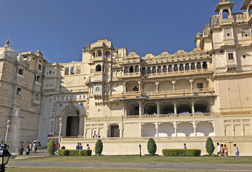 through a number of quadrangles known as chowks. We pause in the main lower courtyard to take in details of granite and marble stonework, carving, intricate balconies and
through a number of quadrangles known as chowks. We pause in the main lower courtyard to take in details of granite and marble stonework, carving, intricate balconies and 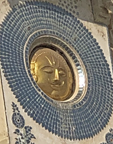 porticoes, and many sun symbols adorning the walls. After we view the enormous main wooden gate, studded with lethal elephant-resisting spikes, Kamal has received permission to use the tiny birdcage elevator to the top floor, normally reserved for the current royal family—Maharana Nahendra Singh Mewar and Princess Nirupama Kumari—and we emerge into the Peacock Courtyard, with three glass mosaic peacocks, colorful decorated doorways and intricately carved balconies above.
porticoes, and many sun symbols adorning the walls. After we view the enormous main wooden gate, studded with lethal elephant-resisting spikes, Kamal has received permission to use the tiny birdcage elevator to the top floor, normally reserved for the current royal family—Maharana Nahendra Singh Mewar and Princess Nirupama Kumari—and we emerge into the Peacock Courtyard, with three glass mosaic peacocks, colorful decorated doorways and intricately carved balconies above.
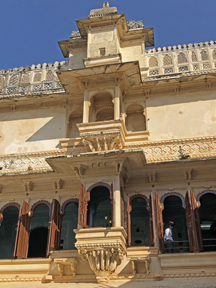 As we enter the foyer of the Peacock Courtyard, Kamal tells of the palace sections connected by zigzag corridors, narrow and uneven stairways, small portals with low lintels intended to make one lean forward while stepping through—all this designed to thwart surprise attacks by enemies. From there we proceed into the Sheesh Mahal, palace of mirrors....thence into the large Manak Chowk audience courtyard, and after a bit of winding around, find the silver galleries, where room after room is filled with the sort of ornate silver beloved by the Victorians. The last case contains huge silver polo and race trophies from the 1800’s. The crystal galleries surround the enormous Durbar Hall—the formal audience hall where rulers held court and reviewed disputes and grievances. The gallery contains full room sets of furniture all made from crystal in 1877 by the British firm F&C Osler, ordered by then Maharana Sajjan Singh. The ruler died before delivery, and the furniture was never unpacked, and remained crated for 110 years. So much opulence is mind-numbing after a while.
As we enter the foyer of the Peacock Courtyard, Kamal tells of the palace sections connected by zigzag corridors, narrow and uneven stairways, small portals with low lintels intended to make one lean forward while stepping through—all this designed to thwart surprise attacks by enemies. From there we proceed into the Sheesh Mahal, palace of mirrors....thence into the large Manak Chowk audience courtyard, and after a bit of winding around, find the silver galleries, where room after room is filled with the sort of ornate silver beloved by the Victorians. The last case contains huge silver polo and race trophies from the 1800’s. The crystal galleries surround the enormous Durbar Hall—the formal audience hall where rulers held court and reviewed disputes and grievances. The gallery contains full room sets of furniture all made from crystal in 1877 by the British firm F&C Osler, ordered by then Maharana Sajjan Singh. The ruler died before delivery, and the furniture was never unpacked, and remained crated for 110 years. So much opulence is mind-numbing after a while.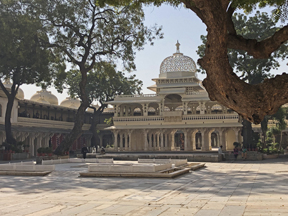
Leaving the palace, our driver C.P. picks us up and we proceed to an art collective where dozens of artists of various skill levels are keeping the art of miniature painting alive...these fellows sit cross-legged with tiny squirrel hair brushes, and paints made from crushed precious stones, such as lapis, carnelian and malachite (the vibrant yellow is made from dried cow’s urine) which create the intense jewel-like colors, inking tiny bits on an elaborate design drawn on paper or silk or even camel bone. These things can take a couple months for something small, to a year for a larger painting. The detail...individual hairs on heads and in beards, skin wrinkles, stitching on clothes are all visible with a bit of magnification—really amazing work.
Kamal has asked us if we are interested in contemporary art, and we answer in the affirmative. There are five major monsoon-filled lakes in Udaipur, all at different elevations and all interconnected, one flowing into the next (one of the boat guides will later tell us he’s seen Lake Pichola completely dry three times in his life). Ten minutes further around nearby Fateh Sagar Lake we alight at Bougainvillea art gallery. A modern multi-floor structure built up again the rocky hillside, the gallery is architecturally interesting in its own right. Modern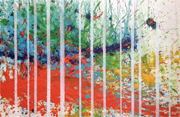 paintings, sculpture and mobiles fill the space. A featured artist is Shorya Mahanot, who began painting at 5, and at age 12 was declared by the UK Guardian “the next Picasso”—perhaps not, but certainly interesting work—faintly Pollock-like. Not a lot in the gallery is to our personal taste (I greatly admire one small bronze, but don’t want to get into the pricing haggling bit) but it is uniformly quality work, and well worth the visit....unless of course you don’t like modern art.
paintings, sculpture and mobiles fill the space. A featured artist is Shorya Mahanot, who began painting at 5, and at age 12 was declared by the UK Guardian “the next Picasso”—perhaps not, but certainly interesting work—faintly Pollock-like. Not a lot in the gallery is to our personal taste (I greatly admire one small bronze, but don’t want to get into the pricing haggling bit) but it is uniformly quality work, and well worth the visit....unless of course you don’t like modern art.
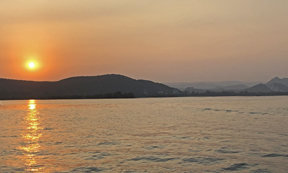 At 4 pm a local guide, the hotels employ—C.D. he says to call him—leads a 45-minute heritage walk around the property, which melds into a sunset cruise around the lake, with a stop at Jag Mandir island just as the sun sinks below the peaks of the Aravalli Hills. Jag Mandir was built and added to in the 15-1600’s as a pleasure garden and day palace. It contains no temple, and no sleeping quarters. When we were last here a couple decades ago, there were not flotillas of boats circling, and almost no visitors to the island. Now it’s sort of a Disney experience. In the same period, Udaipur might have had a handful of hotels, and three of significance...the Lake Palace, the Shiv Nivas in the Udaipur Palace, and the Oberoi Raj Villas on the far shore. We are told there are now hundreds, and several major monstrosities have managed to spring up on the near and far lakeside, despite absolute proscription against any new properties on the lake. When asked why, a shrug, and the words “too much corruption” are the answer.
At 4 pm a local guide, the hotels employ—C.D. he says to call him—leads a 45-minute heritage walk around the property, which melds into a sunset cruise around the lake, with a stop at Jag Mandir island just as the sun sinks below the peaks of the Aravalli Hills. Jag Mandir was built and added to in the 15-1600’s as a pleasure garden and day palace. It contains no temple, and no sleeping quarters. When we were last here a couple decades ago, there were not flotillas of boats circling, and almost no visitors to the island. Now it’s sort of a Disney experience. In the same period, Udaipur might have had a handful of hotels, and three of significance...the Lake Palace, the Shiv Nivas in the Udaipur Palace, and the Oberoi Raj Villas on the far shore. We are told there are now hundreds, and several major monstrosities have managed to spring up on the near and far lakeside, despite absolute proscription against any new properties on the lake. When asked why, a shrug, and the words “too much corruption” are the answer.
That evening we take a nightcap on the upper terrace, looking at the incredible view of the palace and city night lit, as a half-moon rises, and wonder why we didn’t plan longer in this delightful oasis.
Jaipur
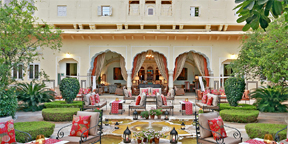 We had previously stayed at Umaid Bagwan in Jaipur, a fantastic palace hotel, but located an inconvenient distance out of town. A hotel which didn’t exist then is the Samode Haveli, a rambling 300-year-old townhouse of an aristocratic family inside a walled compound right in town, which has been converted to a 39-room boutique luxury hotel. There is a very traditional and authentic Rajasthani feel to the complex, with rambling buildings, various courtyards, open loggias, terraces and garden areas. Beautiful flowers are everywhere, and there is birdsong all around. Rooms are scattered between what was originally the mardana, or men’s area and zenana, or women’s area, and twisting, winding corridor’s and passages ensure that we get lost, at least initially.
We had previously stayed at Umaid Bagwan in Jaipur, a fantastic palace hotel, but located an inconvenient distance out of town. A hotel which didn’t exist then is the Samode Haveli, a rambling 300-year-old townhouse of an aristocratic family inside a walled compound right in town, which has been converted to a 39-room boutique luxury hotel. There is a very traditional and authentic Rajasthani feel to the complex, with rambling buildings, various courtyards, open loggias, terraces and garden areas. Beautiful flowers are everywhere, and there is birdsong all around. Rooms are scattered between what was originally the mardana, or men’s area and zenana, or women’s area, and twisting, winding corridor’s and passages ensure that we get lost, at least initially.
The main entry courtyard serves as the open-air lobby, where there is gentle Indian music every evening to accompany cocktails. Through a low doorway, down a few steps, along a potted-shrub lined walkway and past the huge infinity pool, with lovely pool bar is the open-air dining terrace. The restaurant offers a mix of classic Rajasthani dishes and western foods. One can get a caprese salad or a BLT as well as lal mass, a spicy slow cooked lamb dish with laccha paratha.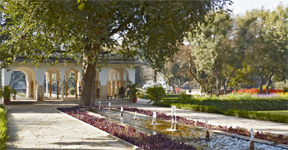
Our suite, one of the Haveli class, is set in enclosed 3-story courtyard in one of the most distant buildings (that getting lost thing), and features black and white marble floors, a lounge area and an outdoor seating terrace overlooking the courtyard. There is a huge bathroom with both claw-foot tub and glass shower stall, and out the back windows are trees through which monkeys swing and play. The only real downside comes from the fact that Samode Haveli is located in the Muslim quarter, and there are several nearby mosques, which means quite loud muezzin’s calling to prayer multiple times per day.
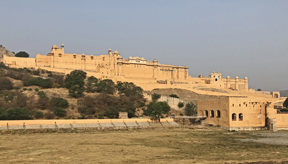 The following morning, we set out with local guide Vikram Rana to visit the Amber Fort, which looms over the town of Amer, about 10 kilometers from downtown Jaipur. The enormous fort, or palace is mixture of Mughal and Rajput architecture and was built of red sandstone and marble in four distinct sections over the course of two centuries, beginning at the end of the 16th. The east facing sun gate is the route taken by an unending string of dozens of elephants carting tourists up to the fort. According to Greaves Tours,
The following morning, we set out with local guide Vikram Rana to visit the Amber Fort, which looms over the town of Amer, about 10 kilometers from downtown Jaipur. The enormous fort, or palace is mixture of Mughal and Rajput architecture and was built of red sandstone and marble in four distinct sections over the course of two centuries, beginning at the end of the 16th. The east facing sun gate is the route taken by an unending string of dozens of elephants carting tourists up to the fort. According to Greaves Tours,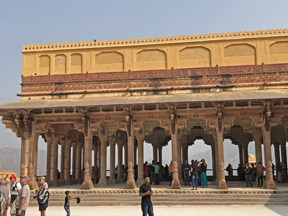 our organizer, these elephants are not well treated, and they boycott their use. Accordingly, our car wanders through the crowded backstreets of Amer, winding slowly up to the top of the rear gate, where we disgorge to enter the fort. Even the overview tour takes over an hour, to see the Mughal style Dil-e-Aaram Garden, the Sheesh Mahal, or palace of mirrors, the beautiful carved marble screens and panels, and the open-air Diwan-e-Am, or hall of public audience, and the enormous silver doors of the temple of Sila Devi.
our organizer, these elephants are not well treated, and they boycott their use. Accordingly, our car wanders through the crowded backstreets of Amer, winding slowly up to the top of the rear gate, where we disgorge to enter the fort. Even the overview tour takes over an hour, to see the Mughal style Dil-e-Aaram Garden, the Sheesh Mahal, or palace of mirrors, the beautiful carved marble screens and panels, and the open-air Diwan-e-Am, or hall of public audience, and the enormous silver doors of the temple of Sila Devi.
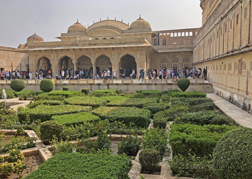 Wandering back down into the town, we pass the Panna Meena ka Kund stepwell, with its Escher-esque symmetrical descending staircases, and make a short visit to the Anokhi Museum, set in a traditional townhouse, which features the art of woodblock printed textiles. Like a Michelin one-star—worth a visit.
Wandering back down into the town, we pass the Panna Meena ka Kund stepwell, with its Escher-esque symmetrical descending staircases, and make a short visit to the Anokhi Museum, set in a traditional townhouse, which features the art of woodblock printed textiles. Like a Michelin one-star—worth a visit.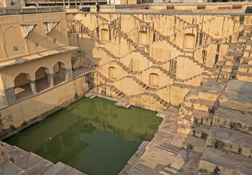
One reason for this trip is to meet up with old and dear friends from San Francisco, who are making their first trip to India, and we happily greet them at cocktail hour with gin & tonics in the open-air courtyard of Samode. We catch up with the details of their itinerary to date over dinner of grilled lambchops and baingan bharta, eggplant curry, on the oil-lamp lit terrace. Wandering more of the back corridors of the Haveli, and climbing what amounts to a ship’s ladder with a rope handrail, we view their heritage room, which is quite atmospheric, and very different from our suite in the farther building.
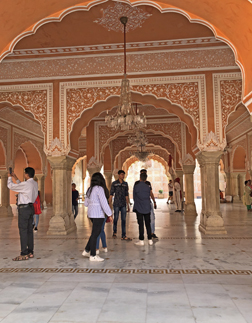 The next day, Vikram first led the way to the Jaipur City Palace and all it’s glory. Built in the early 1700’s by Maharaja Sawai Jai Sing II, in the center of the planned nine-block medieval city after the capital shifted from Amber Fort (which was basically deserted after the move) to be in the important trading city of Jaipur. The rose-hued palace contains a series of buildings, courtyards, gardens, a temple and a museum—Sawai Mansingh II—displaying clothes worn by the maharajas, one of who weighed close to 500 pounds and whose pants could have been worn by a team of football players. One of the interesting points of the palace is the two enormous silver urns, known as the Gangajalis, that were built when Maharaja Madho Singh II sailed to England for the coronation of Edward VII. Singh was a devout Hindu, and for religious purposes believed only water from the Ganges was suitable to drink and bathe in. Any water touched by the English (heathens) was considered impure. Each urn holds almost 1,000 gallons of water, weighs over 800 pounds, and was fashioned from over 7,000 silver coins.
The next day, Vikram first led the way to the Jaipur City Palace and all it’s glory. Built in the early 1700’s by Maharaja Sawai Jai Sing II, in the center of the planned nine-block medieval city after the capital shifted from Amber Fort (which was basically deserted after the move) to be in the important trading city of Jaipur. The rose-hued palace contains a series of buildings, courtyards, gardens, a temple and a museum—Sawai Mansingh II—displaying clothes worn by the maharajas, one of who weighed close to 500 pounds and whose pants could have been worn by a team of football players. One of the interesting points of the palace is the two enormous silver urns, known as the Gangajalis, that were built when Maharaja Madho Singh II sailed to England for the coronation of Edward VII. Singh was a devout Hindu, and for religious purposes believed only water from the Ganges was suitable to drink and bathe in. Any water touched by the English (heathens) was considered impure. Each urn holds almost 1,000 gallons of water, weighs over 800 pounds, and was fashioned from over 7,000 silver coins.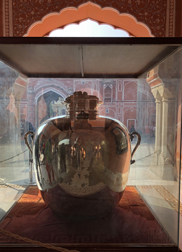
After viewing this fabulous palace, we ventured into the Old City and stopped at a chai masala vendor, well known to Vikram, and sampled some delicious chai. From there we wandered through the narrow streets, which are divided into various craftsman whose families have been plying their trades for centuries. The first street contains the tin workers hammering out plates, platters and bowls. 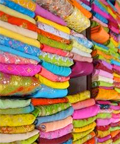 Then onto the sari material wholesalers where reams of colorful fabrics are being looked over by whole families making important decisions on designs. This selection is quite the procedure and involves many people. We passed by the bangle maker’s alley, and then the paper vendor’s street. At one point Vikram pointed out a motorcycle containing a bunch of small boxes. This was the Rat Catcher, who takes the trapped rats out to the countryside and lets them go! This counterintuitive action is to honor the god Ganesha, because the rat is the god’s transportation (hard to picture). The Hindu belief also honors pigeons by feeding them grain as an offering, and cooks all over the city make chapatis not only to feed the family, but the cows wandering the streets, and finally the stray dogs.
Then onto the sari material wholesalers where reams of colorful fabrics are being looked over by whole families making important decisions on designs. This selection is quite the procedure and involves many people. We passed by the bangle maker’s alley, and then the paper vendor’s street. At one point Vikram pointed out a motorcycle containing a bunch of small boxes. This was the Rat Catcher, who takes the trapped rats out to the countryside and lets them go! This counterintuitive action is to honor the god Ganesha, because the rat is the god’s transportation (hard to picture). The Hindu belief also honors pigeons by feeding them grain as an offering, and cooks all over the city make chapatis not only to feed the family, but the cows wandering the streets, and finally the stray dogs.
Shopping is an important part of an Indian visit, and Jaipur has many goods to offer, with jewelry and precious gems a specialty. We make a re-visit to the well-known Gem Palace, where an hour of browsing finally narrows the selection down to a pair of antique Jaipur style gold and emerald earrings, a gold and deep blue sapphire ring, and for me, the gift of both birthday and Christmas presents taken care of early. Exhausted by shopping, we return to Samode Haveli for a G&T and a rest. Troy’s belief is that this hotel is what the Best Exotic Marigold Hotel could have been, with millions of rupees added.
Pushkar
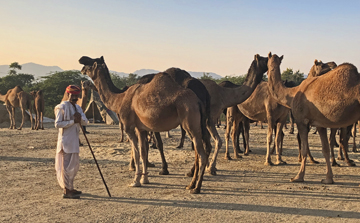 The Pushkar Camel Fair has long been on our bucket list. We were scheduled to go on our last trip to India a dozen years ago, and we got word two days before that the state dept had issued an advisory of expected terrorism, and warned Americans away. We chickened out, didn’t go, and of course there were no incidents. This time we won’t miss it, and having met our old friends the night before at the hotel, we four set out with 8 passenger van, driver and backup driver for the fairly grueling 4.5 hour lurching, bouncing drive to Pushkar, arriving in time for a much needed gin & tonic.
The Pushkar Camel Fair has long been on our bucket list. We were scheduled to go on our last trip to India a dozen years ago, and we got word two days before that the state dept had issued an advisory of expected terrorism, and warned Americans away. We chickened out, didn’t go, and of course there were no incidents. This time we won’t miss it, and having met our old friends the night before at the hotel, we four set out with 8 passenger van, driver and backup driver for the fairly grueling 4.5 hour lurching, bouncing drive to Pushkar, arriving in time for a much needed gin & tonic.
Jodhpur
After a four hour slog from Pushkar, we arrive into Jodhpur’s afternoon traffic jam. Our big bus cannot reach the hotel in the old city, so we debark a couple of blocks south of the clock tower bazaar, and the four of us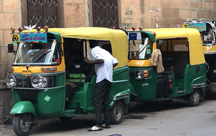 and luggage are loaded into three tuk-tuks, to make the death defying traffic-dodge the ten twisting narrow blocks to the Raas Jodhpur Hotel. This is ensconced in an 18th century Haveli, but unlike Samode Haveli, it is a combination of preserved ancient architecture, and striking new design, all executed in rust red sandstone. The parking courtyard sits just through the old arched entry gate and beyond that is a glass cube reception area with fountains, trees and a waterfall around it. A stone pathway leads past a bamboo screen to a modern building which houses perhaps sixteen rooms, facing the pool courtyard, the open-air dining terrace attached to an old palace building, and looking up to the
and luggage are loaded into three tuk-tuks, to make the death defying traffic-dodge the ten twisting narrow blocks to the Raas Jodhpur Hotel. This is ensconced in an 18th century Haveli, but unlike Samode Haveli, it is a combination of preserved ancient architecture, and striking new design, all executed in rust red sandstone. The parking courtyard sits just through the old arched entry gate and beyond that is a glass cube reception area with fountains, trees and a waterfall around it. A stone pathway leads past a bamboo screen to a modern building which houses perhaps sixteen rooms, facing the pool courtyard, the open-air dining terrace attached to an old palace building, and looking up to the 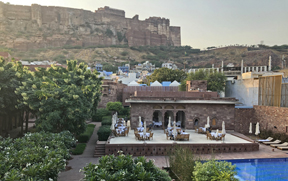 immensity of the 15th century Merenghar Fort perched 400 feet above the skyline. Our exquisitely designed second floor rooms have a terrace overlooking the pool court, and up to the Fort. A folding screen of lattice panels of red stone—an amazing thing—can be opened to the view, or closed to dampen light and sound, of which there is plenty: city and traffic noises, music from cafes above, and worst, an immense speaker tower behind a mosque almost next door. Holy Muezzin, Batman! Five times a day, and much more we will find, all at 100 decibels or more.....yikes!
immensity of the 15th century Merenghar Fort perched 400 feet above the skyline. Our exquisitely designed second floor rooms have a terrace overlooking the pool court, and up to the Fort. A folding screen of lattice panels of red stone—an amazing thing—can be opened to the view, or closed to dampen light and sound, of which there is plenty: city and traffic noises, music from cafes above, and worst, an immense speaker tower behind a mosque almost next door. Holy Muezzin, Batman! Five times a day, and much more we will find, all at 100 decibels or more.....yikes!
There are two restaurants—the one we face, over the pool terrace, called Baradi and a level up in a different building the Darikhana offers both alfresco and indoor dining. The same international and Indian menus are served at both. We variously try lamb pita wraps, the same with falafel, eggplant curry, wild mushroom risotto, tandoori chicken kebabs, homemade tagliatelle pesto, laacha parantha, the Mediterranean mezzo platter, roghan josh, and find the food very good. Service is on Indian time, as usual. The concept of getting drinks right away, with menus, just is not in their blood.
Another block of new rooms sits behind the dining pavilion, a block of heritage rooms to the side, and three heritage suites, a spa complex, and an exercise room complete the splendid boutique hotel. The owners have acquired a couple of adjacent buildings, and have created an upscale retail complex with cafes, bar, 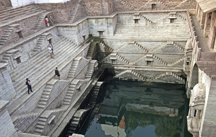 houseware, design, clothing, textile and antique shops. Very nicely done, and pleasant shopping environment, but of course at higher prices by a good bit than the Clock Tower bazaar a few blocks away. Between the hotel and the shopping pavilion is the Toorji Ka Jhalra Step Well, a 200 foot deep water source dating to mid 1700’s and built by one of Maharaja Abhay Singh’s consorts, or concubines, following a long-standing tradition that Royal women could build public water works from their allowances by the king. The zig-zag steps leading down and in, on all four sides, are rather like an Escher staircase etching. The water is very far down now, but marks on the stone show how high it rises during a normal monsoon.
houseware, design, clothing, textile and antique shops. Very nicely done, and pleasant shopping environment, but of course at higher prices by a good bit than the Clock Tower bazaar a few blocks away. Between the hotel and the shopping pavilion is the Toorji Ka Jhalra Step Well, a 200 foot deep water source dating to mid 1700’s and built by one of Maharaja Abhay Singh’s consorts, or concubines, following a long-standing tradition that Royal women could build public water works from their allowances by the king. The zig-zag steps leading down and in, on all four sides, are rather like an Escher staircase etching. The water is very far down now, but marks on the stone show how high it rises during a normal monsoon.
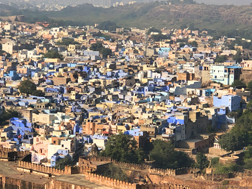 After lunch on the Baradari terrace restaurant, a swim in the bathwater-temperature pool and a nap in the sun, we set out at 4:30 pm for a Mr. Toad’s Wild Ride around the narrow winding streets of the old city in two tuk-tuks. Like all Indian cities, the traffic is thick, crazy and chaotic, pitting pedestrians, cars, bicycle rickshaws, tuk-tuks and an untold number of motorbikes all against each other. We wind around to the older portion of the city on the other side of the fort, and here one can really experience the bluest core of the blue city. The indigo houses are the trademark of Jodphur, and were traditionally only allowed to members of the Brahmin caste. Currently it’s a more widespread practice, and there is a lot of blue. We head downhill and careen through alleys past every sort of shop imaginable, numerous temples, cart vendors of vegetables, fruits, and nuts, racks of bright saris and shawls, piles of woven baskets
After lunch on the Baradari terrace restaurant, a swim in the bathwater-temperature pool and a nap in the sun, we set out at 4:30 pm for a Mr. Toad’s Wild Ride around the narrow winding streets of the old city in two tuk-tuks. Like all Indian cities, the traffic is thick, crazy and chaotic, pitting pedestrians, cars, bicycle rickshaws, tuk-tuks and an untold number of motorbikes all against each other. We wind around to the older portion of the city on the other side of the fort, and here one can really experience the bluest core of the blue city. The indigo houses are the trademark of Jodphur, and were traditionally only allowed to members of the Brahmin caste. Currently it’s a more widespread practice, and there is a lot of blue. We head downhill and careen through alleys past every sort of shop imaginable, numerous temples, cart vendors of vegetables, fruits, and nuts, racks of bright saris and shawls, piles of woven baskets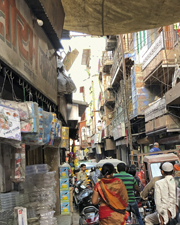 and literally graze the horns of cattle ambling up the street. The traffic is so thick, the streets so narrow that even two tuk tuks have trouble passing in alternate directions, and someone often has to dismount and move a parked motorbike closer to the shopfronts. At one point a delivery vehicle is stopped, clogging traffic including pedestrians in both directions and the ensuing snarl has angry drivers close to attacking the delivery guy. 45 minutes is plenty,
and literally graze the horns of cattle ambling up the street. The traffic is so thick, the streets so narrow that even two tuk tuks have trouble passing in alternate directions, and someone often has to dismount and move a parked motorbike closer to the shopfronts. At one point a delivery vehicle is stopped, clogging traffic including pedestrians in both directions and the ensuing snarl has angry drivers close to attacking the delivery guy. 45 minutes is plenty, 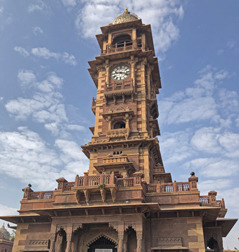 and it’s a relief to dismount and walk past the famous Clocktower and through the associated bazaar back to the hotel.
and it’s a relief to dismount and walk past the famous Clocktower and through the associated bazaar back to the hotel.
That evening we head across the city to the home of Bhavna Raoti, where Greaves has arranged a private cooking class with her, followed by dinner for us. There is an open courtyard in the middle of the house, adjacent to which is what is actually a pretty small and unassuming kitchen. Two large gas burners, no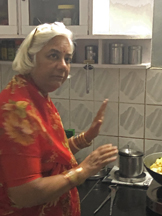 oven, and apartment-sized counter space. She has all of the prep work done, and proceeds to lead us through the steps of cooking murgh makanwalla, the famous butter chicken, aloo gobi
oven, and apartment-sized counter space. She has all of the prep work done, and proceeds to lead us through the steps of cooking murgh makanwalla, the famous butter chicken, aloo gobi 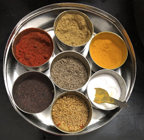 mutter—potatoes, cauliflower and peas, and yellow dal. Her round spice box has seven small containers in it, holding cumin, coriander, turmeric, fenugreek, black cardamom, chile, and salt. At the end of the lesson, a member of her household staff arrives to prepare roti, the everyday unleavened whole
mutter—potatoes, cauliflower and peas, and yellow dal. Her round spice box has seven small containers in it, holding cumin, coriander, turmeric, fenugreek, black cardamom, chile, and salt. At the end of the lesson, a member of her household staff arrives to prepare roti, the everyday unleavened whole 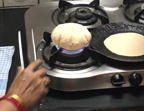 wheat flatbread. She mixes the dough in a large bowl, portions out small balls, rolls each one flat, then bakes it
wheat flatbread. She mixes the dough in a large bowl, portions out small balls, rolls each one flat, then bakes it 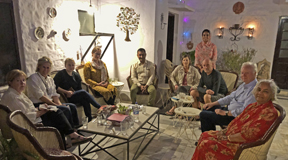 on a round metal plate on a burner, and finishes each one directly on the flame, where it puffs dramatically. All of what we watched being prepared, plus rice and chutneys is arrayed on a buffet, and we eat from plates held on laps sitting around the courtyard.
on a round metal plate on a burner, and finishes each one directly on the flame, where it puffs dramatically. All of what we watched being prepared, plus rice and chutneys is arrayed on a buffet, and we eat from plates held on laps sitting around the courtyard.
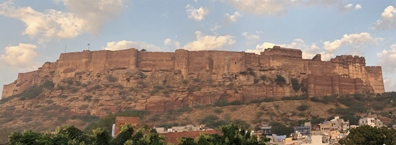 Mehrangarh Fort looms broodingly over the city on a red sandstone butte four hundred feet above the skyline of Jodhpur. There is a steep path to the fort from town, but we elect the next morning to take a taxi up the long winding road around the rear to the main northeast gate, Jai Pol. There are a series of seven gates in all, and we bypass two levels up a short elevator ride. At the gate called Loha Pol, which leads into the main part of the fort, high iron spikes are embedded in the gate to prevent an elephant attack. The Dedh Kamgra Pol bears scars of cannonball strikes.
Mehrangarh Fort looms broodingly over the city on a red sandstone butte four hundred feet above the skyline of Jodhpur. There is a steep path to the fort from town, but we elect the next morning to take a taxi up the long winding road around the rear to the main northeast gate, Jai Pol. There are a series of seven gates in all, and we bypass two levels up a short elevator ride. At the gate called Loha Pol, which leads into the main part of the fort, high iron spikes are embedded in the gate to prevent an elephant attack. The Dedh Kamgra Pol bears scars of cannonball strikes.
One of the largest and best-preserved forts in India, Mehrangarh is sometimes known as the Citadel of the Sun—a reference to the Rathore clan’s mythical descent from the sun god Surya. So enormous is the fort that Rudyard Kipling called it “the work of giants”. The Fort and its enclosed palaces were constructed by the Rathore dynasty over a period of roughly 500 years 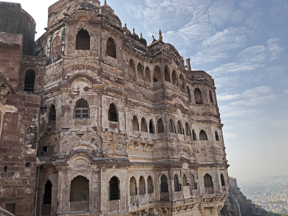 following its foundation in the mid-15th century, and accordingly there is a mix of architecture with varied building styles. Mughals and Rajputs serially fought and defeated each other over those periods, changing possession of the fort, and styles of subsequent construction.
following its foundation in the mid-15th century, and accordingly there is a mix of architecture with varied building styles. Mughals and Rajputs serially fought and defeated each other over those periods, changing possession of the fort, and styles of subsequent construction.
There are intricately carved lace-like stone facades on all of the beautiful palaces within the fort, and it is mind numbing to think of the amount of hand labor used to create all this detail. It’s really a stunning combination of hulking military fortress and lovely elegant palaces
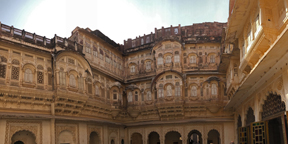 The Sheesh Mahal was the former bedroom of one of the rulers, and is, as are all such named palaces, full of intricately detailed mirror and glass inlay. Jhanki Mahal features a series of white carved marble columns and is the place the ladies of the court watched proceedings below, through the filigreed windows. Moti
The Sheesh Mahal was the former bedroom of one of the rulers, and is, as are all such named palaces, full of intricately detailed mirror and glass inlay. Jhanki Mahal features a series of white carved marble columns and is the place the ladies of the court watched proceedings below, through the filigreed windows. Moti 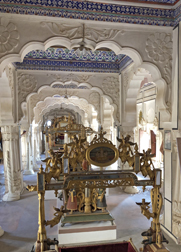 Mahal, the Pearl Palace, contains the royal throne of Jodhpur, the Sringar Chowki.
Mahal, the Pearl Palace, contains the royal throne of Jodhpur, the Sringar Chowki.
The last gate, Suraj Pol opens into the museum, which contains royal memorabilia, weapons, textiles, elephant howdahs, and a magnificent Mughal tent. There is a very well stocked—with high quality goods, not junk—museum shop, where we acquire a small Indian miniature painting of peacocks.
A kilometer to the east, Jaswant Thada mausoleum stands above a handsome green park next to a small lake. Built as a memorial to Maharaja Jaswant Singh II the lovely 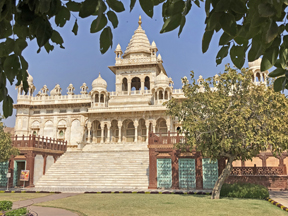 carved gazebos and graceful domes of milk-white marble lead it to also be referred to as the Taj Mahal of Marwar. Adjacent is the cremation ground for the Jodhpur royal families, and four additional square white marble-arched cenotaphs house the remains of other Marwar rulers. Despite its purpose, it’s a very beautiful and peaceful place.
carved gazebos and graceful domes of milk-white marble lead it to also be referred to as the Taj Mahal of Marwar. Adjacent is the cremation ground for the Jodhpur royal families, and four additional square white marble-arched cenotaphs house the remains of other Marwar rulers. Despite its purpose, it’s a very beautiful and peaceful place.
Returning to Jodhpur, we drive past the imposing Umaid Bhawan Palace Hotel. We had stayed there on a previous trip, and intended to go for lunch, but find that it's been completely rented out for a celebrity wedding. Shopping time, our guide has suggested we might like to check out some high quality textiles and woven goods. we arrive at Maheesh Handicrafts, an antique emporium the size of an airplane hanger, and wander the jam-packed main floor viewing furniture, objets, huge sets of carved doors, sculpture, and 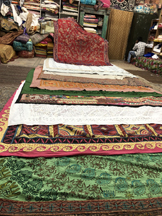 miniature paintings. We descend to a basement crammed floor to ceiling with shelves of textiles of every imaginable color and pattern. We are seated on low benches around a small showroom, and one of the owners and assistants unfurls one after another wool, silk, goat and camel hair and pashmina shawls and throws. Pattern-on-pattern ecru, elegant paisleys, colorful designs—all hand-loomed. He pours water on a stylish paisley camel-hair throw, and amazingly it pools up as if on plastic, and doesn't wet the fabric. He says you can leave it for up to ten minutes before it begins to penetrate. He then teases us by asking us to guess the prices, and then reveals the amazing values they represent. He indicates different ones, stating that they make them for Hermes, Celine, Liberty of London and other high-end fashion names, who sell them at prices dozens of times what they can be had for. We buy a beautiful patterned pashmina throw for $165 that can be found on Hermes website for $2,500. At these prices, we pick up several things to give for Christmas gifts in a couple of months.
miniature paintings. We descend to a basement crammed floor to ceiling with shelves of textiles of every imaginable color and pattern. We are seated on low benches around a small showroom, and one of the owners and assistants unfurls one after another wool, silk, goat and camel hair and pashmina shawls and throws. Pattern-on-pattern ecru, elegant paisleys, colorful designs—all hand-loomed. He pours water on a stylish paisley camel-hair throw, and amazingly it pools up as if on plastic, and doesn't wet the fabric. He says you can leave it for up to ten minutes before it begins to penetrate. He then teases us by asking us to guess the prices, and then reveals the amazing values they represent. He indicates different ones, stating that they make them for Hermes, Celine, Liberty of London and other high-end fashion names, who sell them at prices dozens of times what they can be had for. We buy a beautiful patterned pashmina throw for $165 that can be found on Hermes website for $2,500. At these prices, we pick up several things to give for Christmas gifts in a couple of months.
Jaisalmer
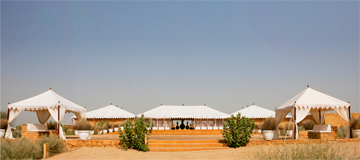 The trip from Pushkar to Jaisalmer is another 5-hour road trip, but mostly on good roads, so not so much stopping, starting and jerking. Finally, we turn off the road onto a dirt track and bounce another few klicks to Sujan the Serai Desert Camp, a Relais & Chateau luxury tented camp set on a 100 acre private estate in the Thar desert, only about 70 km from the Pakistan border. (We will be continually confused about whether the place is called Serai or Sujan, as staff seems to use the words interchangeably).
The trip from Pushkar to Jaisalmer is another 5-hour road trip, but mostly on good roads, so not so much stopping, starting and jerking. Finally, we turn off the road onto a dirt track and bounce another few klicks to Sujan the Serai Desert Camp, a Relais & Chateau luxury tented camp set on a 100 acre private estate in the Thar desert, only about 70 km from the Pakistan border. (We will be continually confused about whether the place is called Serai or Sujan, as staff seems to use the words interchangeably).
A permanent tented camp, with golden limestone floors in public and private tents, Serai is one of the most 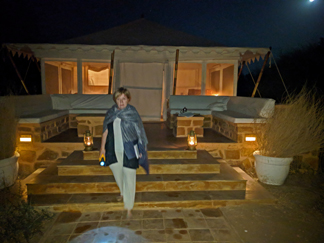 luxurious we’ve stayed at. At the entrance, there is an enormous multi-tent housing reception, bar, library, and dining room. A large stone deck a few steps down is cut with a maze of shallow water-filled channels, which are bottom-lit at night, forming a glowing symbol. Beyond lies the elevated pool built on a golden sandstone plinth, with waterfall cascading off the back, and paths from there lead to 21 large tent rooms. Mature desert landscape fills the areas between paths and tents—austere, but beautiful. Only the photos do it justice. Each tent has an entry terrace with seating, a front sitting area with camp lounge chairs, and a writing desk. The 20 by 20 ft. bedroom features king bed, and two wooden clothing storage racks. Behind is the bathroom with enormous rain shower and double sinks.
luxurious we’ve stayed at. At the entrance, there is an enormous multi-tent housing reception, bar, library, and dining room. A large stone deck a few steps down is cut with a maze of shallow water-filled channels, which are bottom-lit at night, forming a glowing symbol. Beyond lies the elevated pool built on a golden sandstone plinth, with waterfall cascading off the back, and paths from there lead to 21 large tent rooms. Mature desert landscape fills the areas between paths and tents—austere, but beautiful. Only the photos do it justice. Each tent has an entry terrace with seating, a front sitting area with camp lounge chairs, and a writing desk. The 20 by 20 ft. bedroom features king bed, and two wooden clothing storage racks. Behind is the bathroom with enormous rain shower and double sinks.
This experience so reminds us of the best of Africa. Staff are variously dressed in desert khaki, long native white robes and red turbans, or crisp white shirts and khaki trousers, and service is terrific. Sometimes things have to be repeated or clarified, as there are varying levels of English proficiency. And the quiet, too, reminds us of the dark continent. Out in the middle of the Thar Desert, there is much birdsong, some insect and animal scurrying sounds, the backdrop of falling water from the pool cascade, and little else.
We're quite fascinated by the landscape of Serai that weaves in and around the complex. Comparing construction photos in the bar from roughly 20 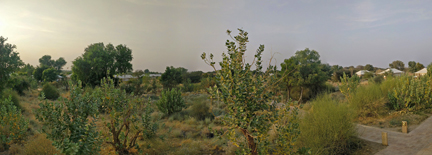 years ago, and the surrounding desert outside the camp, versus the vegetation in the complex, they seem worlds apart. I asked G.M. Chatterjee what the landscaping project during construction consisted of. He answered in one word: water. All of the local desert plants were withered or dormant In seed form in the desert, and when given regular water, become the lush if austere vegetation that makes the camp seem so unique.
years ago, and the surrounding desert outside the camp, versus the vegetation in the complex, they seem worlds apart. I asked G.M. Chatterjee what the landscaping project during construction consisted of. He answered in one word: water. All of the local desert plants were withered or dormant In seed form in the desert, and when given regular water, become the lush if austere vegetation that makes the camp seem so unique.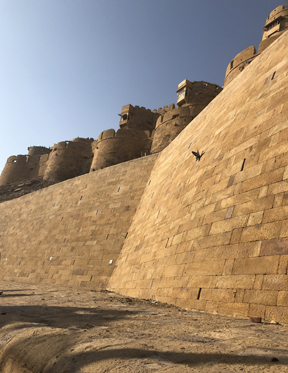
Jaisalmer Fort, a UNESCO World Heritage site, also known as Sonar Kila (Golden Fort-for the local, yellow sandstone from which it is built) with its wall of semi-circular bastions is set atop the highest point—the slope sided Tricuta rock—in the encompassing expanse of undulating buff-colored sand. The fort is unique in that it is still inhabited.....roughly 2,000 people make their homes within the Fort walls. Residents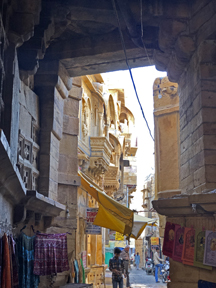 must be from the two highest castes—Brahmin or Rajput—Merchants and Servants need not apply. Within the Fort, overlooking the main square—Dessera Chowk—is the Palace of Maharwal, clad in intricately carved panels of the golden sandstone. Previously the home of the city’s rulers, it now contains the Fort Museum. From inside the fort, and up in the high
must be from the two highest castes—Brahmin or Rajput—Merchants and Servants need not apply. Within the Fort, overlooking the main square—Dessera Chowk—is the Palace of Maharwal, clad in intricately carved panels of the golden sandstone. Previously the home of the city’s rulers, it now contains the Fort Museum. From inside the fort, and up in the high 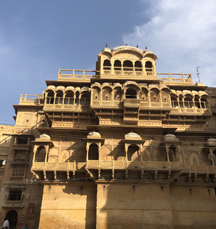 building, there are views of the new town of Jaisalmer. The inside of the fort has become a retail emporium. Every house has a vendor displaying something to buy.
building, there are views of the new town of Jaisalmer. The inside of the fort has become a retail emporium. Every house has a vendor displaying something to buy.
Jaisalmer is renowned for its intricately carved yellow sandstone. This work can be seen all over the houses and important buildings. Even new buildings are ornamented with this beautiful golden stonework. According to Hindu tradition, cows and dogs (all animals, actually) are 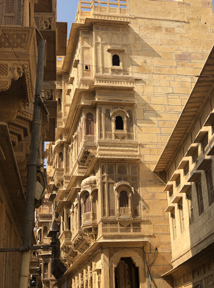 holy, and accordingly, they are all over the place. Every family feeds the animals. All the cooks make chapattis not just for the family, and we saw a woman with a platter of them passing rounds of bread out first to the cows and then to the dogs.
holy, and accordingly, they are all over the place. Every family feeds the animals. All the cooks make chapattis not just for the family, and we saw a woman with a platter of them passing rounds of bread out first to the cows and then to the dogs.
Back at Serai, as that moon rises, we take Jodphur gin and tonics on the terrace overlooking a flaring firepit, under a canopy of bright stars. Small onion breads, shrimp skewers and delicious fried chicken winglets are passed on silver platters.
Dinner each night is served on a different terrace – the entry courtyard, the pool terrace with its low water maze, with candle lanterns and toasty iron firepits next to each table. The first night we sample artichoke and hearts of palm salad, cold cucumber and coriander soup and roast lamb rack. The wine list is extensive, and we are pleased with Sula Sauvignon Blanc, Fratelli chardonnay and find the Grover Chene Réserve 2015 blend to be exceptional.
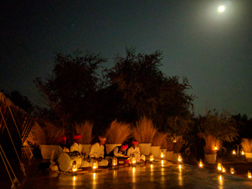 As we dine our last night under the one-day waning moon on the pool terrace, an amazing musical troupe called the Manganiars entertains. They are the traditional bards of the western desert, their home village only a half hour from Serai, with a history that goes back 13 centuries. They believe they are descended from the Rajputs, and their songs are passed down between generations as a form of oral history. They play that odd Indian accordian-like harmonium, a 17-string kamaicha, the dholak hand drum, and most astonishingly a set of teak blocks known as a khartaal, which they wave around as they play. The dizzying, intricate and syncopated rhythms they can accomplish are simply astounding.
As we dine our last night under the one-day waning moon on the pool terrace, an amazing musical troupe called the Manganiars entertains. They are the traditional bards of the western desert, their home village only a half hour from Serai, with a history that goes back 13 centuries. They believe they are descended from the Rajputs, and their songs are passed down between generations as a form of oral history. They play that odd Indian accordian-like harmonium, a 17-string kamaicha, the dholak hand drum, and most astonishingly a set of teak blocks known as a khartaal, which they wave around as they play. The dizzying, intricate and syncopated rhythms they can accomplish are simply astounding.
The hypnotic rhythms, the scent of the desert flora at night, the crackling of the log fires, and the last dregs from our wineglasses lure our eyelids earthward and feet tentwards as the final night of our Indian adventure draws to a close…..